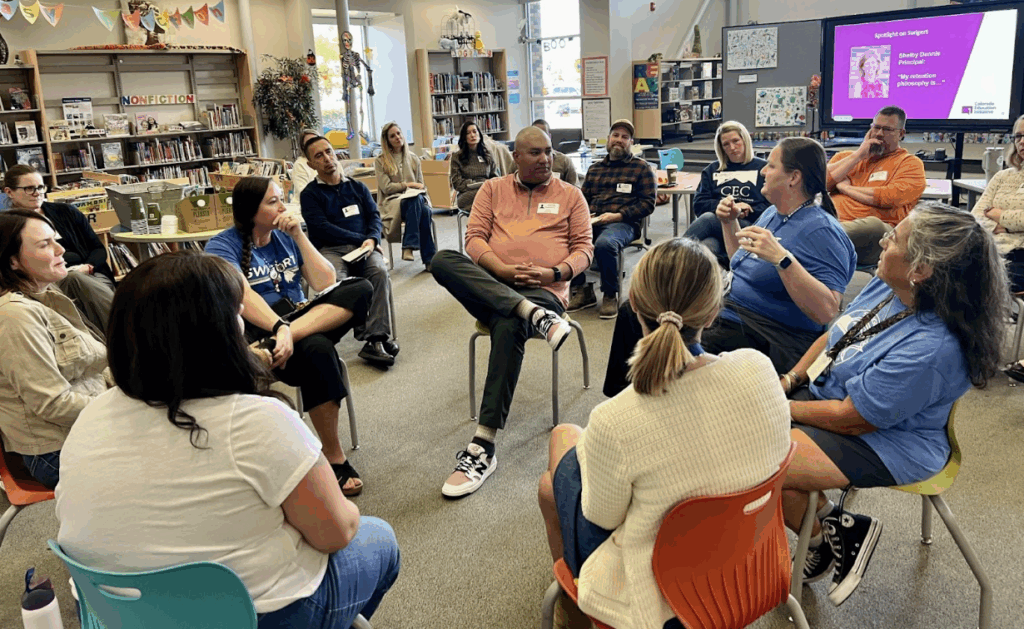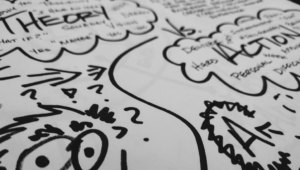Trust & Transformation: Why Local Intermediaries Are the Key to Education’s Future

We are surrounded by intermediaries. Banks manage the exchange between people and capital. Trainers connect individuals to their fitness goals. Real estate agents guide home buying through the complexity of markets and contracts. In every sector, intermediaries build bridges between systems and people, translating complexity into access and opportunity.
In education, the same dynamic holds true, though we often underestimate its power. Local intermediaries are the connective tissue between policy and practice, vision and execution, innovation and sustainability. They convene partners, translate strategy, and anchor change in relationships rather than compliance.
At Getting Smart and the Center for Innovation in Education, we believe that you can’t automate localized, systemic change. It requires people who live in the communities they are transforming, people who understand the history, relationships, and rhythms of local life. Intermediaries operate in the middle ground, between state capitals and classrooms, translating broad policy into locally grounded practice. They are the unsung heroes of educational change, the connective tissue that makes reform last.
The Local Advantage: Intermediaries in Action
Intermediaries are indispensable because they are rooted in the regions they serve, allowing them to convene partners, align systems, and grow ideas that fit their unique context. Across the country, diverse organizations prove that sustainable transformation happens locally, not through mandates, but through relationships and trust. A few of these organizations are described below.
| Intermediary | Region | Primary Function |
| Colorado Education Initiative (CEI) | Colorado | Acts as a crucial bridge builder, aligning innovation with state policy by partnering with districts and Boards of Cooperative Educational Services (BOCES). |
| Real World Learning (RWL) | Kansas City Region | Builds cross-state agreements that align workforce needs with student outcomes (“Market Value Assets”), serving as a backbone organization. |
| Future Focused Education (FFE) | New Mexico | Centers local wisdom and youth voice to co-create policy, leading directly to legislative wins (e.g., funding for behavioral health programs). |
| Future of Learning Council (FLC) | Michigan | A member-driven coalition of school districts and Intermediate School Districts (ISDs) that builds educator-led movements around personalized learning, and now adding more advocacy state work. |
| Center for the Future of Learning (CFL) | Nevada | Convenes the Nevada Future of Learning Network, amplifying local innovation by bringing together youth, educators, and community leaders. |
| Center for Next Generation Leadership (UKNextGen) | Kentucky | Builds capacity of districts to provide vibrant learning experiences to students and connects local school district innovation networks (Local Laboratories of Learning) directly with state-level accountability redesign efforts. David Cook, from Learning Ecosystems Design, is a consistent partner in this work. |
| New Hampshire Learning Initiative (NHLI) | New Hampshire | Initially an initiative to introduce an innovative assessment model for districts, has grown into a national effort to rethink education and assessment by supporting educators, district leaders, and building administrators |
| Office of Innovation for Education (OIE) | Arkansas | Facilitates statewide initiatives, provides professional learning, and builds capacity for innovation through coaching, collaboration, and data-informed decision-making. |
| Michigan Assessment Consortium (MAC) | Michigan | A professional association of educators who believe quality education depends on accurate, balanced, and meaningful assessment and provides leadership and services to advance high-quality assessment practices. |
| Georgia Leadership Institute for School Improvement (GLISI) | Georgia | Designs transformational leadership experiences for successful schools and thriving communities, offering training, consulting, and technical assistance to leaders. |
Virginia Leads Innovation Work (VaLIN) | Virginia | A cohort of Virginia school divisions focused on high school re-design towards more personalized competency based learning through coaching, professional learning, design sprints, communities of practice, and convenings. |
Across these examples, a pattern emerges: intermediaries succeed when they act as connectors, not controllers, when they lead by building trust, shared ownership of change and they often hold a vision for a region or a state that outlasts any one administration or era.
Navigating the Tension: Compliance and Agility
Intermediaries operate in a constant state of balance. Political turnover, policy shifts, and compliance mandates often disrupt progress just as momentum builds. Yet these organizations persist because they know how to translate volatility into adaptability, protecting promising work while cultivating what’s next.
Educational Service Districts (ESDs), Boards of Cooperative Educational Services (BOCES), and Intermediate School Districts (ISDs) exemplify this tension and were designed to provide equitable, nimble support. Born from policy rather than philanthropy, these organizations occupy a unique middle space: governmental enough to carry authority and resources and regional enough to understand local context. Yet over time, policy and funding structures can push these organizations toward compliance and oversight, which can impede rapid innovation.
The Integrated Model: Strategic Public Service
The best public agencies prove that this compliance and innovation tension is manageable. The ISD members of the Michigan FLC are prime examples. They strategically align and build coherence around their compliance measures while investing in their regional centers for professional learning and innovation. They leverage their authority not to prescribe, but to convene and scale proven innovations, supporting new practices that are embedded within the system and have access to sustainable resources. The goal is about enabling the practice of these organizations to be more responsive and intentional in how and where they provide support.
The most effective intermediaries blend compliance and creativity. They use public authority to build coherence while empowering schools to experiment.
Take Eaton RESA in Michigan, which serves as both a compliance hub and a driver of systems change. By aligning professional learning, career readiness, and competency-based badging systems, they demonstrate how to hold both stability and innovation in the same hand. Similarly, Muskegon ISD has become a regional catalyst for personalized learning, consistently leveraging its role to invite, not impose, change. They worked with other systems to support a Place-, Project-, and Problem-Based (3P) learning initiative with local districts.
These examples remind us that the future of public education will depend not on dismantling structures but on redesigning them to enable responsiveness and collaboration.
Leading by Example: Building the Practice
If intermediaries are the connective tissue, the larger ecosystem must ensure they are nourished. National and state partners have a critical role to play—not as external drivers, but as long-term partners.
This means shifting from delivering programs to partnering to advance local aims. Like other effective national organizations, we at Getting Smart and the Center for Innovation in Education (CIE) actively seek and utilize ways to support local intermediaries from a national vantage point. Here are a few examples of how we see national organizations meaningfully supporting local intermediaries:
- Thought Partnering and Systematizing: We work alongside intermediaries to help leaders systematize their efforts, convene critical networks around shared outcomes, and support strategic partnerships. We help local leaders codify what works and connect it to broader systems change.
- Building a Shared Body of Evidence: We focus on lifting up local stories and evidence of successful practice to build external legitimacy, support internal coherence, and accelerate the adoption of practitioner-led innovation across the broader ecosystem. Examples from other states enhance the legitimacy of the work of other individual state intermediaries.
- Convening and Peer Learning: Building cross-state networks, supporting peer learning that helps intermediaries become more effective in their local contexts. These networks demonstrate what’s possible when intermediaries learn together, share strategies, and support each other through political transitions and funding uncertainties.
While actions like these show promise, the ecosystem must evolve further to better support intermediaries.
Strengthening the Ecosystem: Three Priorities for Shared Action
Effective state education agencies already model many of these behaviors, maintaining long-established, productive partnerships with non-governmental organizations and regional agencies. They view these partnerships as a strategic way to infuse the system with agility and diverse expertise while maintaining equitable service.
The infrastructure for collaborative support already exists. These cross-state networks like those developed by CIE function as critical friends and communities of practice, providing essential support. In these networks, intermediaries have supported each other to successfully apply for federal funding, form their own district networks, and amplify their stories and voices on the federal policy stage. The infrastructure exists, it needs investment and expansion, not invention.
To deepen this support, we urge the education ecosystem to commit to the following priorities:
- Fund the Practice, Not Just the Program: Invest in building the capacity within intermediary organizations—funding professional learning, cross-state peer networks, and data infrastructure—rather than only funding time-limited, top-down programs.
- Share Innovation, Don’t Impose It: National research groups act as “learning conduits,” bringing exposure to proven, innovative strategies and helping local intermediaries adapt them to their unique regional contexts.
- Build the Bench: Invest in intermediary leaders. These organizations are only as strong as their relationships and expertise, making talent development a long-term investment in the entire ecosystem’s sustainability.
Sustaining Change: The Human Key to the Future
The long-term success of education reform hinges on building local capacity through relationships, responsiveness, and regional trust. Sustainable change requires more than a program; it requires people who are empowered to lead it.
The power of effective intermediaries lies in their ability to braid external expertise with local knowledge. Local solutions are not created in isolation; they often arise when new, innovative practices and strategies (which may originate from national partners, research, or observations of other successful systems) are effectively filtered, adapted, and owned by local leaders who know the local ecosystem best.

Rebecca Midles








0 Comments
Leave a Comment
Your email address will not be published. All fields are required.